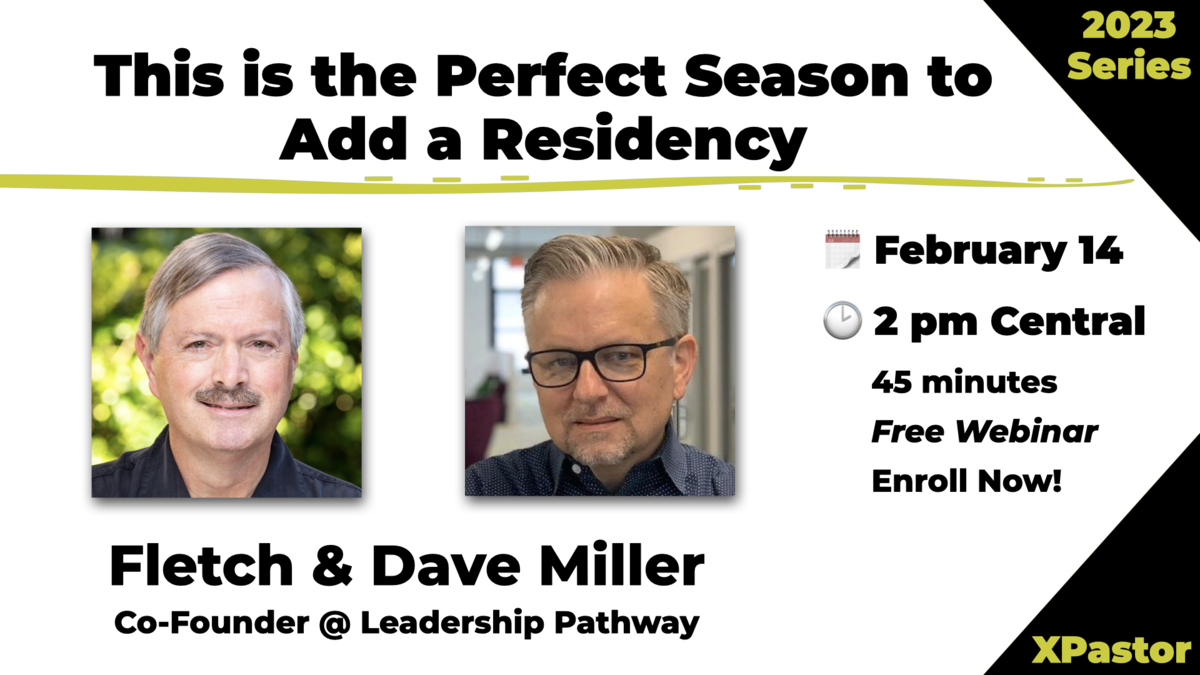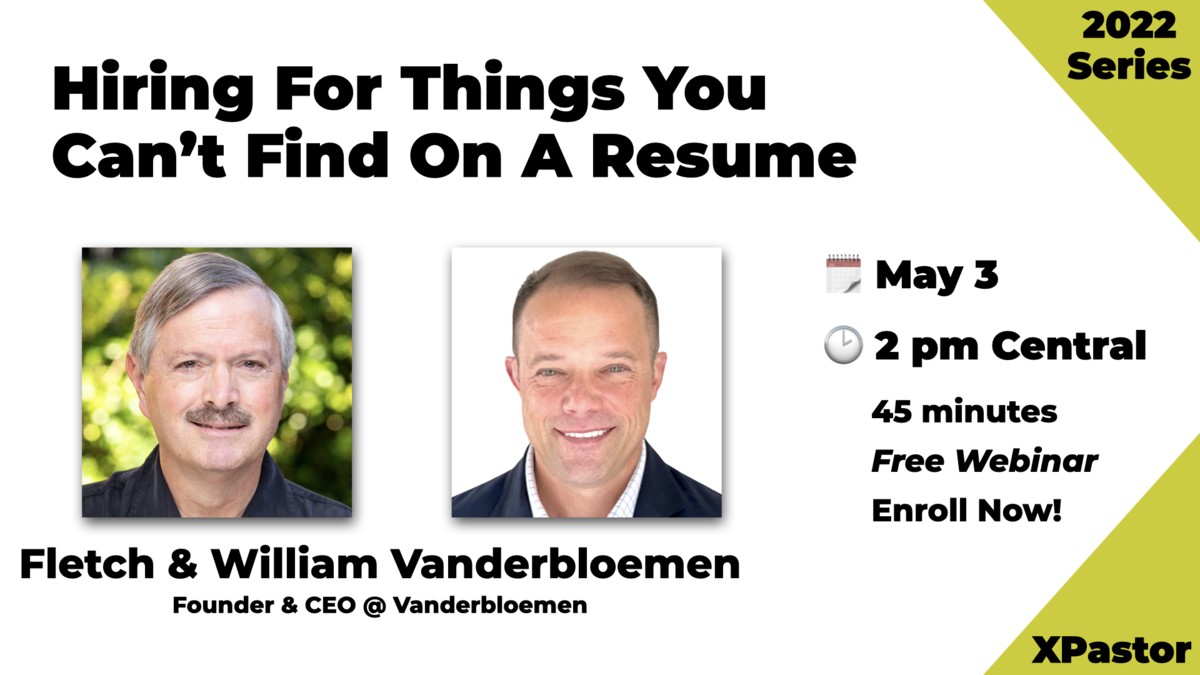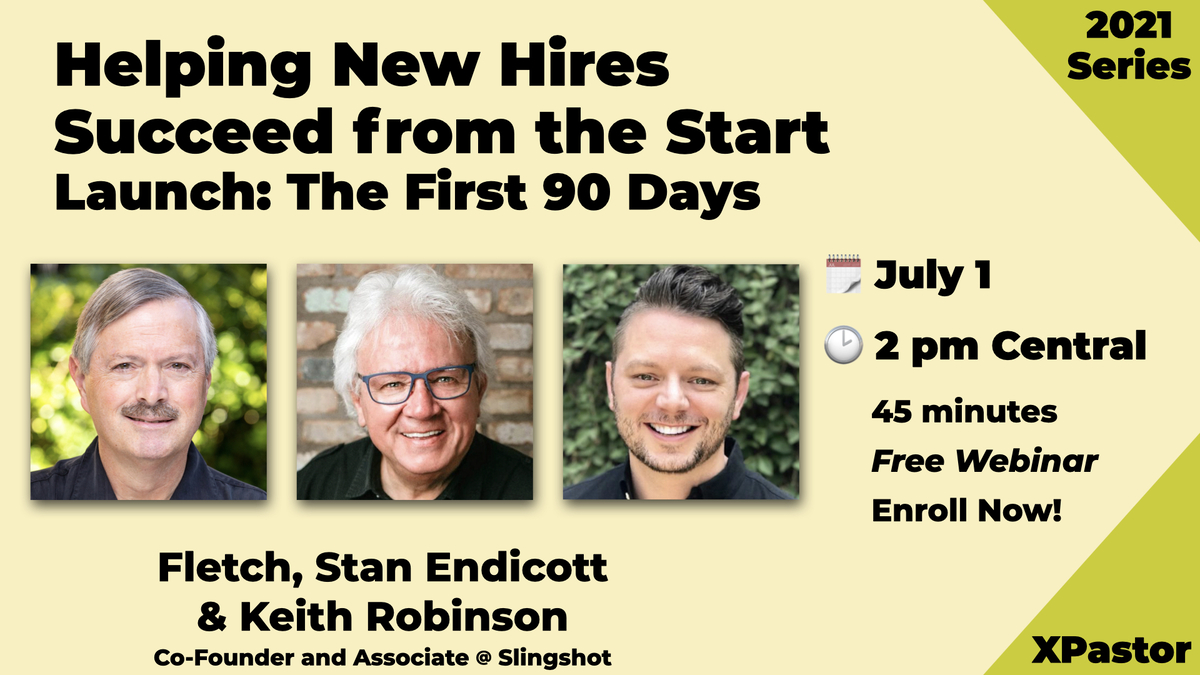Executive Pastors face an enormous challenge—hiring great staff. An XP called me because he had a hiring dilemma. “I think that I have a great candidate, but I need your input.” In working with church leaders around the country, I see a common challenge of hiring great staff.
Everyone knows that hiring is a challenge—and this pastor was no exception. “A friend introduced me to this guy. This is great since we just started looking for the right person.” In the early stages of the search process, people will recommend friends. This is good because you get a range of candidates that you might not find on your own. And this is bad because you may get a candidate before you are ready to begin the interview process.
I asked the pastor if he had a written job description, or, even better, an Opportunity Profile. “Well, we’re working on the job description and … I don’t even know what an opportunity profile is.” Because the pastor didn’t have either one of these items prepared, he was operating according to the mixed-up proverb, “Ready, shoot, aim.” Since the pastor didn’t know what he was looking for, then how would he know that he found the right person? Many churches do their searches this way, rather haphazard and backwards.
Let’s define terms: A Job Description is your statement of a person’s intended scope of ministry. An Opportunity Profile is a multi-page statement that explains the vision and ministry of the church, the culture of the local community, and the type of person for a specific ministry position that you are looking for.
This article gives a once-over of the essential elements and process of hiring great staff.
Essential Elements of Hiring
To hire great staff, you must know what you are looking for. This requires an Opportunity Profile where you describe the church, community, culture and ministry. You need to put in print what may seem obvious; “we are 1,000 in worship each Sunday, have men and women on the governing board, and are building a new worship center.” Also, you will want to describe the kind of person that you are looking for. Are you looking for a “visionary leader,” an “implementer of the vision,” or a “shepherd to a certain age group?” Believe it or not, the best Opportunity Profiles run about seven single-spaced pages.
In preparing the Opportunity Profile, you will also want to write the proposed Job Description. This needs to remain an internal document for a period of time. You don’t want to publicize the job description too much since you’ll want some flexibility with it. The details of the job description, not the major items, need to be able to be changed when you have a great candidate. For example, if you put in the Job Description that the person will “do pastoral counseling as needed,” will you automatically disqualify someone who is a poor counselor? Generally, the minor details of a job description can change according to a particular candidate. Having prepared the Opportunity Profile and Job Description, you are ready to do the “Ten Steps to Great Hiring.”
The first step is to receive resumes
When you post your opening on a job board, it is best to require that all resumes come by email. You will thank yourself later for doing this; this will enable you to easily send resumes to others in the church for their review. My preference is for the resumes to initially come to the leader of the search process, not to an administrative assistant. The reason for this is that some of your best candidates will need absolute confidentiality in the early stages. Their churches may be unreasonable if they learn that the person is looking for a new position—often giving the person two week’s notice on the spot.
Another essential element is to determine who will do the interviewing. Some churches desire to have a search team, while others have one individual lead the search—and incorporate various other people at stages. If you choose to have a search team, generally all the team members receive every resume. This can be a waste of time, as eighty percent of the submitted resumes may not fit your Opportunity Profile.
The second step is to respond to each applicant
A short email is all this is necessary. I generally write something as simple as “Thanks for your resume. We will get back to you within ten days.” This treats each applicant with dignity, telling him or her that you have received the resume. One person wrote to me saying: “Thanks … I sent resumes to other churches and didn’t hear anything for months, if ever.”
The third step is what I call the “Ten Day Traffic Signal”
From experience, about eighty to ninety percent of applicants don’t fit the Opportunity Profile. One or two key leaders can review all resumes and respond within ten days. Why ten days? This sets an internal clock that will require that you process the mounds of resumes. You won’t get backlogged and bludgeoned by the sheer numbers of applicants.
Many applicants won’t carefully read your Opportunity Profile or will hope that you are flexible with it. Don’t be flexible with your Opportunity Profile. For example, if you state that you are a charismatic church, then you don’t need to consider someone who is opposed to sign gifts. If you are a highly doctrinal church, then you won’t want to consider someone who does not agree with your doctrinal statement. If you are a seeker church, then you won’t want to consider someone who only values worship services for believers.
By empowering one or two people to review all the resumes, you will save yourself time and energy with those people who obviously don’t fit your organization. Write each applicant an email that says, “Thanks, but no thanks.” You don’t need to give a reason for the decline—as a matter of fact it is better not to give a reason. I prefer to say: “Our needs are different from your gifts and abilities—and this is much more a statement about us than about you. God’s best to you.”
The fourth step in the search process is the initial phone call
When you find a resume that stands out to you, then it is time to make a phone call. Call and talk through the resume. Ask the person what they find interesting about your church and why they are leaving their current position. Have the person comment on the Opportunity Profile and what interests them in the job. If you like the response from the initial phone call, pray about the person. Ask God to give you insight into what you have learned about the person.
The fifth step is to have a second round of phone calls
Generally, I do the initial phone call and have others do this round of calls. What you want to see is whether or not the candidate can connect with others.
The sixth step is the initial in-person interview
This is generally a one-day interview at your church. I like to have small groups of people interview the candidate all day long. At my church in Austin, all seven Elders liked to meet each candidate, so I planned a lunch with half of them for this first interview. The key players of the organization need to meet with the candidate. Often, the Senior Pastor will meet with the candidate for thirty to sixty minutes. Subordinates and peers in the department will also have a group meeting for about thirty to sixty minutes.
The seventh step is having the candidate write their interaction with the Opportunity Profile and possibly do an interview at the candidate’s church
If you like the candidate so far, then have them commit their thought to paper after having seen your church. They should be able to articulate the vision, scope and nature of the job. If they can’t, then they are not the right person for you. For some positions, you may need to send people to evaluate the candidate on his/her home turf. This is especially true when hiring youth workers—you need to go and see the candidate’s youth program.
Now is also a great time to do reference checks and background checks. Often, I get a Human Resource professional or a trained counselor to do these calls.
The eighth step is a big one—it is the second interview
When you are inviting someone for the second interview, you are saying “We are really interested in hiring you.” You should have the feeling that this is the right person for you—and that the only thing keeping you from hiring him/her is the second interview.
For this reason, I structure the second interview quite differently. The first interview had small groups of decision-makers that met with the candidate for one day. The second interview should involve many groups of people over several days—and for some positions this may include a Sunday with teaching responsibilities. You want to see how the candidate will interact with groups of five, ten and twenty people. Can he or she communicate vision within the context of the ministry position? People on your staff and in the church may ask some tough questions; can the candidate gently handle those questions?
Since the second interview encompasses many people, there is a threat level for the candidate. The candidate may need to tell their existing church that they are being interviewed by you—the Christian world can be quite connected. All it takes is one person in your church to know one person in the candidate’s church—and then the “cat is out of the bag.” For this reason, you need to be “almost sure” that this is the candidate that you are going to hire.
The ninth step is decision-making time
You need to assemble your key leaders and decide if this is the right person for your church. If you have had many people involved in the second interview stage, then have someone collect the responses from those individuals. Determine the salary based on the person’s experience as it fits within your salary guidelines.
The tenth and final step in hiring is the offer phone call and letter
It is best to offer the position first by phone—or in person, if possible. A warm voice can let the person feel the excitement and emotion that you have for the individual. Follow up the phone call with an emailed offer letter that explains salary and benefits. One of the most important areas for Executive Pastors is to hire great staff. Start with the Opportunity Profile and Job Description. Then, follow these “Ten Steps to Great Hiring.”
Pray at every step and seek God’s advice in hiring your staff. Hiring is an art and a science. After reading this, you may desire to consult a search firm to do the legwork for you! Remember that if you don’t know what you are looking for, then you will hit your target every time. “Firing” a person is much tougher than taking the time to hire the right person the first time.
This article was first published in ChurchExecutive magazine in April, 2006.











